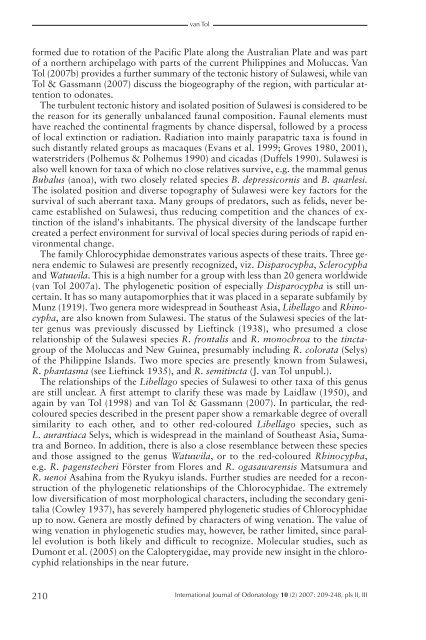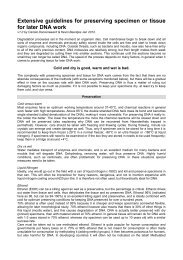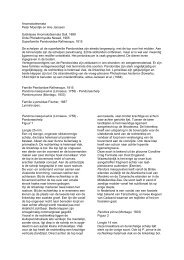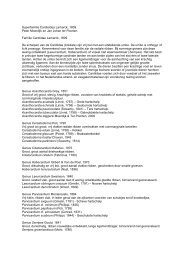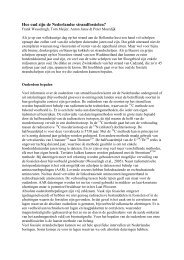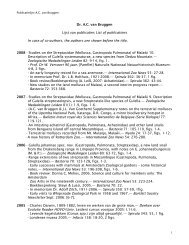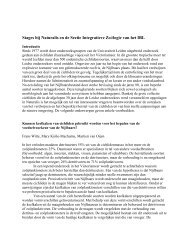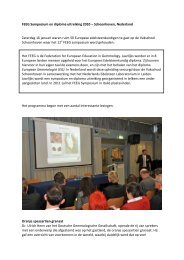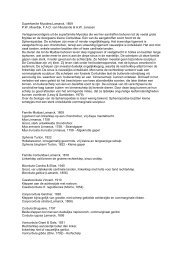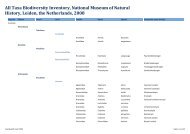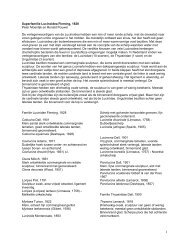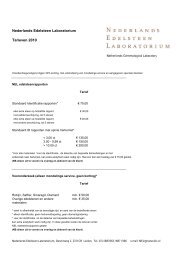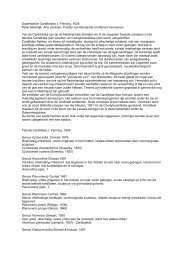The Odonata of Sulawesi and adjacent islands ... - science . naturalis
The Odonata of Sulawesi and adjacent islands ... - science . naturalis
The Odonata of Sulawesi and adjacent islands ... - science . naturalis
Create successful ePaper yourself
Turn your PDF publications into a flip-book with our unique Google optimized e-Paper software.
210<br />
van Tol<br />
formed due to rotation <strong>of</strong> the Pacific Plate along the Australian Plate <strong>and</strong> was part<br />
<strong>of</strong> a northern archipelago with parts <strong>of</strong> the current Philippines <strong>and</strong> Moluccas. Van<br />
Tol (2007b) provides a further summary <strong>of</strong> the tectonic history <strong>of</strong> <strong>Sulawesi</strong>, while van<br />
Tol & Gassmann (2007) discuss the biogeography <strong>of</strong> the region, with particular attention<br />
to odonates.<br />
<strong>The</strong> turbulent tectonic history <strong>and</strong> isolated position <strong>of</strong> <strong>Sulawesi</strong> is considered to be<br />
the reason for its generally unbalanced faunal composition. Faunal elements must<br />
have reached the continental fragments by chance dispersal, followed by a process<br />
<strong>of</strong> local extinction or radiation. Radiation into mainly parapatric taxa is found in<br />
such distantly related groups as macaques (Evans et al. 1999; Groves 1980, 2001),<br />
waterstriders (Polhemus & Polhemus 1990) <strong>and</strong> cicadas (Duffels 1990). <strong>Sulawesi</strong> is<br />
also well known for taxa <strong>of</strong> which no close relatives survive, e.g. the mammal genus<br />
Bubalus (anoa), with two closely related species B. depressicornis <strong>and</strong> B. quarlesi.<br />
<strong>The</strong> isolated position <strong>and</strong> diverse topography <strong>of</strong> <strong>Sulawesi</strong> were key factors for the<br />
survival <strong>of</strong> such aberrant taxa. Many groups <strong>of</strong> predators, such as felids, never became<br />
established on <strong>Sulawesi</strong>, thus reducing competition <strong>and</strong> the chances <strong>of</strong> extinction<br />
<strong>of</strong> the isl<strong>and</strong>'s inhabitants. <strong>The</strong> physical diversity <strong>of</strong> the l<strong>and</strong>scape further<br />
created a perfect environment for survival <strong>of</strong> local species during periods <strong>of</strong> rapid environmental<br />
change.<br />
<strong>The</strong> family Chlorocyphidae demonstrates various aspects <strong>of</strong> these traits. Three genera<br />
endemic to <strong>Sulawesi</strong> are presently recognized, viz. Disparocypha, Sclerocypha<br />
<strong>and</strong> Watuwila. This is a high number for a group with less than 20 genera worldwide<br />
(van Tol 2007a). <strong>The</strong> phylogenetic position <strong>of</strong> especially Disparocypha is still uncertain.<br />
It has so many autapomorphies that it was placed in a separate subfamily by<br />
Munz (1919). Two genera more widespread in Southeast Asia, Libellago <strong>and</strong> Rhino -<br />
cypha, are also known from <strong>Sulawesi</strong>. <strong>The</strong> status <strong>of</strong> the <strong>Sulawesi</strong> species <strong>of</strong> the latter<br />
genus was previously discussed by Lieftinck (1938), who presumed a close<br />
relationship <strong>of</strong> the <strong>Sulawesi</strong> species R. frontalis <strong>and</strong> R. monochroa to the tinctagroup<br />
<strong>of</strong> the Moluccas <strong>and</strong> New Guinea, presumably including R. colorata (Selys)<br />
<strong>of</strong> the Philippine Isl<strong>and</strong>s. Two more species are presently known from <strong>Sulawesi</strong>,<br />
R. phantasma (see Lieftinck 1935), <strong>and</strong> R. semitincta (J. van Tol unpubl.).<br />
<strong>The</strong> relationships <strong>of</strong> the Libellago species <strong>of</strong> <strong>Sulawesi</strong> to other taxa <strong>of</strong> this genus<br />
are still unclear. A first attempt to clarify these was made by Laidlaw (1950), <strong>and</strong><br />
again by van Tol (1998) <strong>and</strong> van Tol & Gassmann (2007). In particular, the redcoloured<br />
species described in the present paper show a remarkable degree <strong>of</strong> overall<br />
similarity to each other, <strong>and</strong> to other red-coloured Libellago species, such as<br />
L. aurantiaca Selys, which is widespread in the mainl<strong>and</strong> <strong>of</strong> Southeast Asia, Sumatra<br />
<strong>and</strong> Borneo. In addition, there is also a close resemblance between these species<br />
<strong>and</strong> those assigned to the genus Watuwila, or to the red-coloured Rhinocypha,<br />
e.g. R. pagenstecheri Förster from Flores <strong>and</strong> R. ogasawarensis Matsumura <strong>and</strong><br />
R. uenoi Asahina from the Ryukyu isl<strong>and</strong>s. Further studies are needed for a recon -<br />
struction <strong>of</strong> the phylogenetic relationships <strong>of</strong> the Chlorocyphidae. <strong>The</strong> extremely<br />
low diversification <strong>of</strong> most morphological characters, including the secondary geni -<br />
talia (Cowley 1937), has severely hampered phylogenetic studies <strong>of</strong> Chlorocyphidae<br />
up to now. Genera are mostly defined by characters <strong>of</strong> wing venation. <strong>The</strong> value <strong>of</strong><br />
wing venation in phylogenetic studies may, however, be rather limited, since parallel<br />
evolution is both likely <strong>and</strong> difficult to recognize. Molecular studies, such as<br />
Dumont et al. (2005) on the Calopterygidae, may provide new insight in the chloro -<br />
cyphid relationships in the near future.<br />
International Journal <strong>of</strong> Odonatology 10 (2) 2007: 209-248, pls II, III


